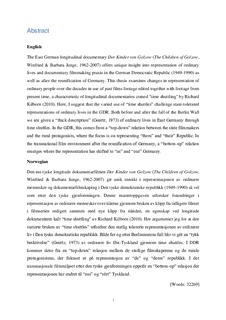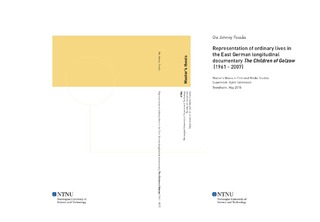| dc.contributor.advisor | Sørenssen, Bjørn | |
| dc.contributor.author | Fossås, Ole Johnny | |
| dc.date.accessioned | 2018-06-27T13:31:04Z | |
| dc.date.available | 2018-06-27T13:31:04Z | |
| dc.date.issued | 2018 | |
| dc.identifier.uri | http://hdl.handle.net/11250/2503384 | |
| dc.description.abstract | Den øst-tyske longitude dokumentarfilmen Der Kinder von Golzow (The Children of Golzow, Winfried & Barbara Junge, 1961-2007) gir unik innsikt i representasjonen av ordinære mennesker og dokumentarfilmskaping i Den tyske demokratiske republikk (1949-1990) så vel som etter den tyske gjenforeningen. Denne masteroppgaven utforsker forandringer i representasjon av ordinære mennesker over tiårene gjennom bruken av klipp fra tidligere filmer i filmserien redigert sammen med nye klipp fra nåtiden, en egenskap ved longitude dokumentarer kalt “time shuttling” av Richard Kilborn (2010). Her argumenter jeg for at den varierte bruken av “time shuttles” utfordrer den statlig tolererte representasjonen av ordinære liv i Den tyske demokratiske republikk. Både før og etter Berlinmurens fall blir vi gitt en “tykk beskrivelse” (Geertz, 1973) av ordinære liv Øst-Tyskland gjennom time shuttles. I DDR kommer dette fra en “top-down” relasjon mellom de statlige filmskaperene og de rurale protagonistene, der fokuset er på representasjon av “de” og “deres” republikk. I det transnasjonale filmmiljøet etter den tyske gjenforeningen oppstår en “bottom-up” relasjon der representasjonen har endret til “oss” og “vårt” Tyskland. | nb_NO |
| dc.description.abstract | The East German longitudinal documentary Der Kinder von Golzow (The Children of Golzow, Winfried & Barbara Junge, 1961-2007) offers unique insight into representation of ordinary lives and documentary filmmaking praxis in the German Democratic Republic (1949-1990) as well as after the reunification of Germany. This thesis examines changes in representation of ordinary people over the decades in use of past films footage edited together with footage from present time, a characteristic of longitudinal documentaries coined "time shuttling" by Richard Kilborn (2010). Here, I suggest that the varied use of “time shuttles” challenge state-tolerated representations of ordinary lives in the GDR. Both before and after the fall of the Berlin Wall we are given a “thick description” (Geertz, 1973) of ordinary lives in East Germany through time shuttles. In the GDR, this comes from a “top-down” relation between the state filmmakers and the rural protagonists, where the focus is on representing “them” and “their” Republic. In the transnational film environment after the reunification of Germany, a “bottom-up” relation emerges where the representation has shifted to “us” and “our” Germany. | nb_NO |
| dc.language.iso | eng | nb_NO |
| dc.publisher | NTNU | nb_NO |
| dc.subject | gdr | nb_NO |
| dc.subject | representation | nb_NO |
| dc.subject | dokumentar | nb_NO |
| dc.subject | documentary | nb_NO |
| dc.subject | longitudinal documentary | nb_NO |
| dc.subject | thick description | nb_NO |
| dc.subject | øst-tyskland | nb_NO |
| dc.subject | defa | nb_NO |
| dc.subject | time shuttles | nb_NO |
| dc.title | Representation of ordinary lives in the East German longitudinal documentary The Children of Golzow (1961 - 2007) | nb_NO |
| dc.type | Master thesis | nb_NO |
| dc.subject.nsi | VDP::Humaniora: 000 | nb_NO |

